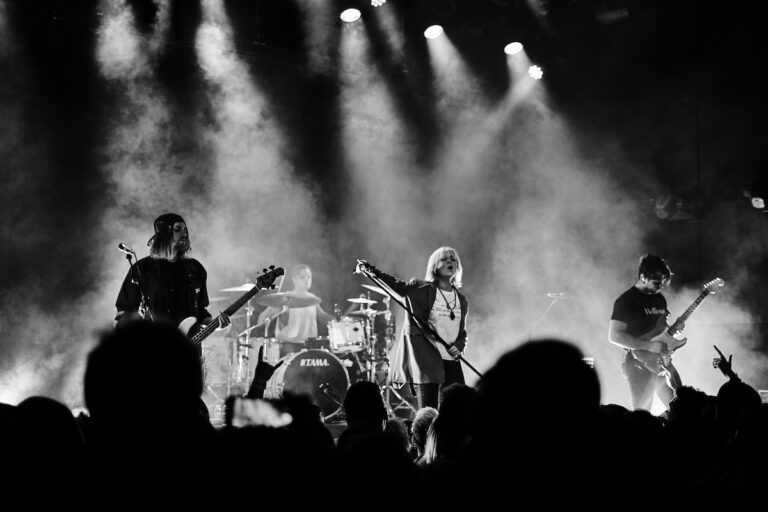It’s no secret the idea of a band—or being in one—once felt like a rite of passage for countless teens. In the 1990s and early 2000s, the pop-punk and emo movements gave rise to unforgettable groups that captured a generation’s angst and energy.
Reflecting On Where Bands Started
Bands like Green Day (formed in 1987 in the East Bay, California punk scene), Fall Out Boy (who emerged from Chicago’s hardcore community in 2001), and My Chemical Romance (born in New Jersey in 2001 after the September 11 attacks inspired Gerard Way to start writing music) weren’t just acts—they were cultural touchstones. Their songs became the soundtrack to adolescent rebellion, heartbreak, and identity.
Many of these bands came together in organic ways: garage practices, high school friendships, and word-of-mouth promotion long before algorithms or viral clips could decide who “made it.” Mayday Parade, for example, was formed when members of two Tallahassee bands merged after selling CDs outside a show on Warped Tour.
Derek Sanders, the band’s vocalist, later reflected on those early days in a 2024 interview with Joe Vulpis on the Lightweights Podcast: “We were just a group of kids in Tallahassee who loved music and wanted to play. We were practicing in garages, playing little shows wherever we could, and slowly building something together. There wasn’t a grand plan or a marketing strategy—it was just organic, and that made it special.”
That ethos—four kids with guitars and a drummer, dreaming of connecting through music—was once at the core of the pop-punk and emo identity. But as fans aged and moved on from their teenage years, something shifted.
By the mid-2010s, the aesthetic, sound, and spirit of emo were being carried not by bands, but by solo artists blending the genre into rap and trap.
From Garage Bands to Bedroom Icons
The integration began subtly. In 2014, Long Beach artist Lil Peep began posting tracks like “Keep My Coo” on SoundCloud. His music fused dark, confessional themes typical of pop-punk with the heavy bass and hi-hat rolls of trap production. By the time of his 2017 debut Come Over When You’re Sober, Pt. 1, Peep had become a pioneer of what came to be called emo rap, turning bedrooms into stages and laptops into recording studios.
After Peep’s death in 2017, the genre didn’t fade—it grew. Artists like Juice WRLD, Trippie Redd, Lil Xan, Lil Tracy, and SoFaygo expanded the sound, pushing the genre deeper into the mainstream. Juice WRLD, in particular, left a legacy far larger than his short life. His hit “All Girls Are the Same” declared, “All girls are the same, they’re rotting my brain,” while “Robbery” captured heartbreak with lines like, “She told me put my heart in the bag, and nobody gets hurt.”
These lyrics resonated with middle schoolers, high schoolers, and young adults who saw their own vulnerability mirrored in his pain. Juice WRLD’s organic fan base adored him, and even after his passing in 2019, his influence continues to ripple across genres—his legacy almost certainly extending beyond generations.
Figures like Lil Uzi Vert carried this emotional openness into superstardom. Songs like “XO TOUR Llif3” (“Push me to the edge, all my friends are dead”) and “The Way Life Goes” (“I know it hurts sometimes, but you’ll get over it”) became anthems of youthful despair and perseverance, streaming billions of times worldwide.
Uzi also openly credited shock-rock figures like Marilyn Manson and the notorious GG Allin as influences, channeling their outsider energy into a new aesthetic that blended emo’s pain with hip-hop swagger. Tracks like “Money Longer” reinforced his star power, and his debut album cemented him as a leader of a new kind of rockstar: one without a band.
The Aesthetic Carries Over
It wasn’t just the sound that migrated. The aesthetics of emo and pop-punk—dyed hair, painted nails, biker chains, chokers, and heavy eyeliner—re-emerged in solo rap stars like Lil Uzi Vert, Lil Peep, and even The Weeknd, who leaned into darker imagery during his Trilogy era.
These artists embodied the same tortured-yet-glamorous archetype once held by Gerard Way or Billie Joe Armstrong, but now they did it alone, commanding stages as singular figures rather than members of a group.
The look and feel of the late ’90s and early 2000s punk scene had found a second life, proof that the culture was bigger than any one genre—it was a mood, an identity, a way of being.
Why the Industry Shifted
This transition from bands to solo artists was also about economics. Record labels find it cheaper and easier to market a single person who embodies an entire movement than to manage the logistics, personalities, and expenses of a five-piece band.
Advances in production software mean one artist can replicate the sound of an entire group—digital drums, layered guitars, and synth textures can create the illusion of a full band without the need to rehearse in garages for years.
Sanders’ reflection on Mayday Parade’s beginnings highlights what has been lost in this shift: the camaraderie, trial-and-error, and collective struggle of young musicians building something from scratch. Today, viral hits can launch a career overnight, often before an artist has even played a live show.
That raises an important question: has something essential about the genre’s communal roots been traded for accessibility and speed?
Nostalgia Never Dies
For older fans, emo and pop-punk never truly disappeared—it simply became interwoven with who they are. Festivals help preserve that legacy, giving them a chance to relive it in real time. The When We Were Young Festival in Las Vegas has brought together nostalgic crowds with legacy acts like Paramore, My Chemical Romance, and Blink-182, allowing fans to reconnect with the same music that once defined their youth.
In 2025, the Vans Warped Tour returned for its 30th anniversary, reviving a traveling showcase that had been dormant since 2019. Featuring dozens of bands, from iconic headliners to newer acts, the comeback underscored the festival’s role as a cultural hub for generations of alternative fans.
Warped Tour founder Kevin Lyman reflected, “This is about giving a new generation the chance to feel that same sense of belonging and freedom that Warped has always championed.”
Recently, the All-American Rejects have also gone viral by staging surprise backyard concerts across the U.S., a direct nod back to the garages and small hometown shows where this genre was born. These performances are not just spectacles of nostalgia—they’re reminders of how deeply rooted the music is in everyday spaces and how easily it can return there.
That longing for belonging extends beyond concerts. Musician and playwright Will Braithwaite created Mourning Wood, a two-act rock musical about a fictional 2007 pop-punk band, complete with an original soundtrack. Songs like “Raining at Your House 2,” “All I Want for Christmas (Is My Life Back),” and “Los Angela” channel the very essence of the genre—catchy hooks, vulnerable storytelling, and power-chord energy.
Braithwaite crafted the show as both a tribute and a personal expression, weaving the nostalgia of his youth into a story that resonates with anyone who ever scribbled lyrics in a notebook or dreamt of escaping their small town with a guitar.
Through festivals, musicals, and backyard concerts alike, the legacy of pop-punk and emo remains alive, carried forward by those who grew up with it and still crave its cathartic release.
The Next Wave Lives On
Meanwhile, the emotional DIY tradition continues underground. Midwest emo thrives through regional bands like Dear Cincinnati, Cardboard Swords, and Thoughts on Bowling, who echo the raw sincerity of earlier eras while carving out their own unique space.
These groups rarely aim for viral fame or mainstream recognition. Instead, they focus on the tight-knit communities that sustain them, playing small clubs, basements, and independent venues that mirror the garage origins of the genre.
What distinguishes Midwest emo is its intimacy. Unlike the polished production of emo-rap or the grandiosity of nostalgia festivals, these bands emphasize intricate guitar lines, layered melodies, and lyrics that feel more like private confessions than pop anthems. Their work thrives on vulnerability and proximity—the kind of connection where thirty people in a cramped room can feel like the most important audience in the world.
In this way, Midwest emo ensures that while the genre may no longer dominate radio charts, it remains deeply alive. It reminds listeners that emo was never just about the scale of the stage, but about the honesty of the stories being told.
Echoes of the Garage
So, what happened to the garage? It didn’t disappear—it evolved. Where once four kids with guitars and a drummer represented rebellion, today a teenager with a cracked version of FL Studio can create songs that touch millions. The medium has changed, but the message remains: music as an outlet, a release, a lifeline.
From Lil Peep’s SoundCloud uploads to Juice WRLD’s confessional freestyles, from Lil Uzi Vert’s rock-star bravado to the enduring legacy of Warped Tour and Midwest emo, the garage’s spirit lives on in new forms. It’s in the nostalgia of fans screaming along at When We Were Young.
It’s in the vulnerability of a play like Mourning Wood. It’s in the basements of the Midwest where kids still pick up guitars and hope someone is listening. And it’s even in backyard concerts where legacy acts like the All-American Rejects remind us how this all began.
The instruments may have changed. The platforms may have shifted. But the heart—the garage—still echoes.



